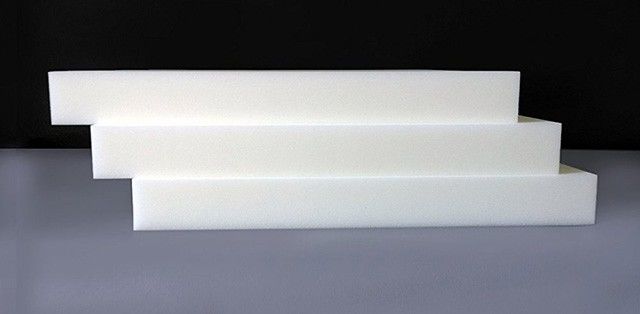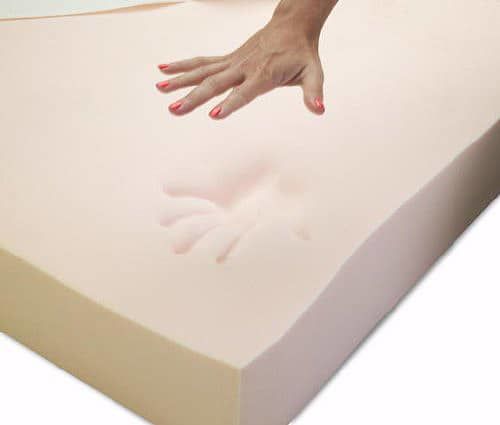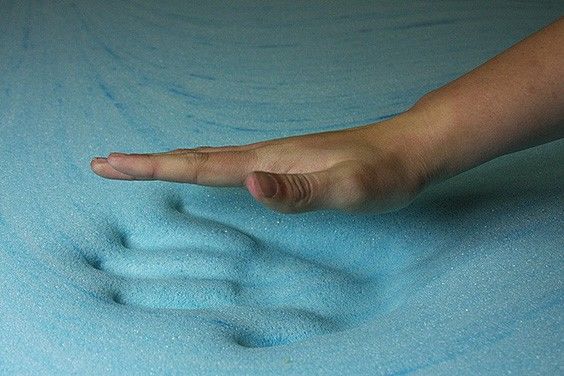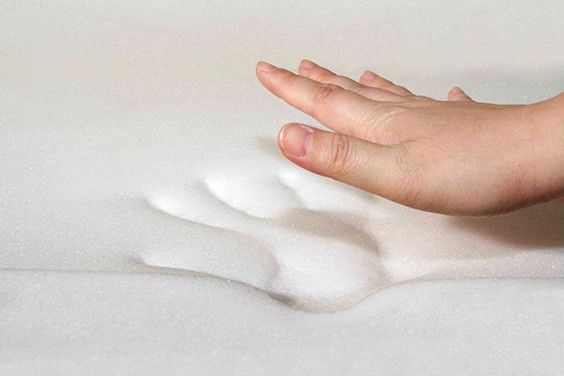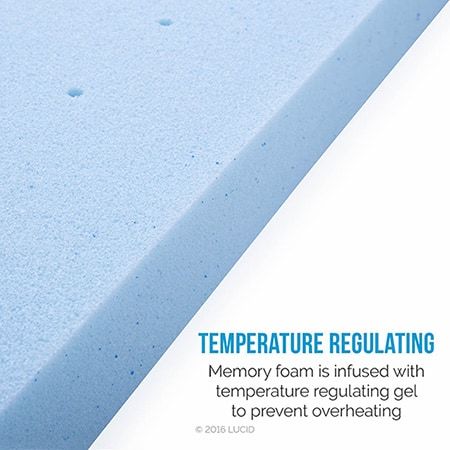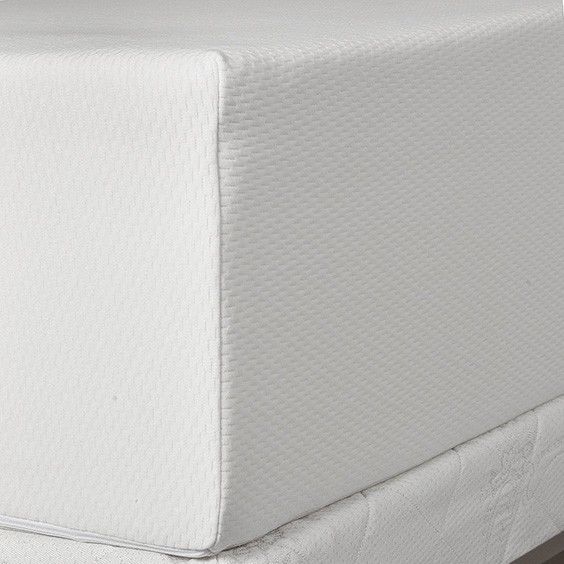Regular polyurethane foam is a staple material for bedding, used in both the comfort and support layers of mainstream mattresses for near about a century. However, the last few decades have seen an unprecedented growth in all avenues of technology – one of the seemingly trivial consequences of which has been the innovation and development of enhanced bedding materials.
Memory (or viscoelastic) foam is one such material, created with the intention to provide shock absorbing seats to astronauts being lifted into space, but ultimately finding its true calling as a therapeutic, conforming mattress comfort material.
Today, the market is flooded with products that utilize one or both of these materials at their cores, so it is important to know the characteristics of both, especially how they contrast and complement one another.
With that in mind, here’s a foam vs memory foam breakdown to provide you a basis for comparing mattresses that use these materials.
Basics of Polyurethane Foam
Polyurethane foam is perhaps the most widely used material in bedding (as well as a whole host of other applications). Low density polyurethane is favored by many manufacturers as a top layer material to create a soft initial feel (that doesn’t last very long) but does make for a good first impression.
Higher grade polyurethane (i.e. with higher density), is used to create highly resilient and progressively resistant support cores that hold up the more pressing parts of your body, that would otherwise sink through a soft comfort layer.
The durability of polyurethane is dependent upon its density: low density foams will start showing signs of deterioration a couple of years into their use, while high resilience foams will last for years without any tangible alteration in their performance.
The Pros and Cons
Pros
- Generally inexpensive.
- Available in a wide range of firmness ratings.
- Can provide both resilient support and pressure relief simply by varying density and firmness.
- Simple to maintain.
- Cooler
Cons
- Not as durable as memory foam.
- Doesn’t provide conforming support.
- Doesn’t completely eliminate motion transfer.
Comfort and Pressure Relief
Even low density polyurethane can offer decent springy support (though it won’t last very long, which is why I don’t recommend it at all, unless the mattress is to be used only sparingly). Moving on to HD and HR grade polyurethane – you can get resilient comfort that will last you for years, provided that the manufacturer does not go crazy with the thickness for short term good impressions.
Resilient comfort means that you’ll be getting a mattress that bounces back after you put pressure on it – the degree of firmness will determine how much it reacts to your body weight. For instance, the softer varieties of high density polyurethane foam could relax your pressure points through their compressibility alone – and at a much lower cost than the other candidate at that, but they’ll be less bouncy as a consequence.
Heat Retention and Breathability
While not the coolest material around, polyfoam does have an open cell structure which makes it automatically better at thermal conduction away from your body.
Durability
For both viscoelastic and polyurethane, durability is largely dependent on the density of the material.
Low density polyurethane foam starts to sag after a couple of years – sooner if it is used more ‘intensely’, but high quality, high density foam (with density north of 2 lb./cu.ft.) can be expected to last far longer. That said, it still won’t age as gracefully as viscoelastic does.
Motion Transfer
While polyurethane is not terrible at reducing motion – especially the firmer varieties – it is not as point elastic as viscoelastic foam, and does transfer some of the pressure to the farther reaches of the bed.
Basics of Memory Foam
Memory foam is a viscoelastic material: it is known for its ability to both absorb and redistribute pressure from a body falling upon it, enabling it to form a conforming cradle that matches your sleeping style – this in turn results in pressure being taken away from the hard points e.g. hips and shoulders for a side sleeper, so that a more natural spinal position can be achieved.
Viscoelastic foam by itself isn’t able to provide total support – pressure relief is more its forte. For a mattress to be both supportive and pressure relieving, the base will need to comprise of a harder, more resilient material such as HD polyfoam.
In terms of composition, viscoelastic foam is closely related to regular polyurethane, with the exception that it uses additional chemicals to achieve its viscoelastic nature. High quality viscoelastic foam – that is to say, with a density surpassing 4 lb./cu.ft., usually retains its conforming ability for much longer than other types of foam.
The Pros and Cons
Pros
- Conforms to the shape of your body.
- Provides personalized pressure relief.
- Good at motion isolation.
- Can provide cradling support when combined with a decent base.
Cons
- Pricey.
- Hot.
- Sensitive to temperature extremes.
- Initial chemical smell.
Support
Memory Foam Vs Low Density Foam
Viscoelastic foam provides what is referred to by some as ‘dead’ support – this is because it absorbs most of the impact of your body, and reflects it minimally, so it lacks the springiness or ‘resilience’ of polyurethane.
Furthermore, because of its ability to melt away locally according to your body heat and weight, it offer hard support at all – so more than a few inches of viscoelastic in a comfort layer can lead to spinal misalignment, especially for weighty individuals (unless there’s a harder support layer underneath, as is the norm with modern mattresses).
Low density polyurethane (under 1.5 lb./cu.ft.), while lacking the viscoelastic qualities of memory foam, offers the same soft support but with a bit more spring. However, it too won’t be able to sustain the major weight of your body, and will require additional support materials underneath to fully hold up your body.
Memory Foam Vs High Density Foam
As mentioned before, viscoelastic foam does not offer any hard support. However, high density (1.5 to 2 lb./cu.ft.) and high resilience (2.5 lb./cu.ft. density and 2.4 support factor) foams can be made to offer both soft support and deep support.
Depending on the degree of firmness as well as the quality, HD and HR foam can be used reliably in any support role, whereas viscoelastic is restricted for use virtually exclusively in comfort layers. In fact, many reputable local manufacturers combine high density viscoelastic foam / high density foam mattress hybrids that offer soft surface conformity and deep support simultaneously.
Comfort and Pressure Relief
Thanks to its conforming, cradling nature, viscoelastic foam can target the parts of your body that tend to stick out and create awkward spinal positions that result in back ache. It shapes itself around these parts and alleviates pressure from them, thereby yielding superior pain relief.
That said, the overall feel you get from a viscoelastic mattress will be of sleeping ‘in’ the mattress rather than sleeping ‘on’ it – so if you’re expecting something with a bit more kick, this isn’t the best choice.
Heat Retention and Breathability
Traditional viscoelastic foam, with its non-breathable closed cell structure, has a tendency to run hot – an issue compounded by its inherent responsivity to heat which causes it to sink further inwards, thereby making the cradle even hotter.
Open cell memory foam was developed to mitigate this very issue – and it has been successful to a varying degree. Further down the road, manufacturers started to incorporate special gel beads inside the open cell structure to enhance heat transfer and breathability even further.
At the end of the day though, viscoelastic is still the hottest type of bedding material, and is not recommended for tropical settings, particularly when no active air conditioning is available.
Firmness
Memory foam, unless it is of a high compressive modulus and appropriately thick (over 3”), is very soft – it has to be, so it can sink in and create that enveloping cradle it is so famed for. On the other hand, polyurethane is available in varying degrees of firmness – ranging from very soft to very firm.
In general, firmness is characterized by the material’s Indentation Load-Deflection (or Indentation Force-Deflection) value which is gauged from a standardized physical test. The greater the ILD value, the higher the firmness of the mattress.
10 (super soft) to 14 (semi-rigid) is a typical ILD range for viscoelastic foam mattresses, while that for polyurethane ranges from 6 to 45 ILD. It is evident then, which of the two materials has more variation in firmness.
Durability
For both viscoelastic and polyurethane, durability is largely dependent on the density of the material.
Viscoelastic mattresses with a density greater than 4 lb./cu.ft. will last for several years, and retain their characteristics without any visible change. Even when viscoelastic foam does start to deteriorate, it becomes softer instead of settling into a hard lump – eventually, it begins to feel like you’re sleeping in a fluid, and that’s the time to replace it.
Motion Transfer
Being a viscoelastic material, memory foam has high point elasticity, which enables it to react to pressure very locally – so the person sleeping on the other side of the bed won’t be woken up due to your motion in the middle of the night.
Maintenance
For both polyurethane foam and memory foam mattresses, it is recommended that you rotate them once every three months or so, to allow the material to rest and regain some of its original shape.
In the case of viscoelastic foam, I would also advise you to use it in a moderate and regulated environment (with respect to humidity and temperature). Too cold, and the viscoelastic material could become hard and easier to wear away; too hot, and its cell structure may start to get permanently deformed.
Pricing
Because of the extra processes and materials involved in its manufacture, the cost of viscoelastic foam runs higher than regular polyurethane, something that is reflected in the considerable price gap between mattresses that use liberal amounts of viscoelastic and those that use polyurethane exclusively.
Memory Foam vs Reflex Foam
If you like the idea of viscoelastic foam, but can’t afford it, yet you still want something that offers better physical conformity than regular polyurethane, there’s a special variant of polyurethane foam called reflex foam that merits a discussion.
Reflex foam is HD polyurethane with medium firmness, which utilizes bubbles (instead of holes as in the case of viscoelastic foam) to achieve its contouring nature. When pressure is applied, the bubbles give way under the weight differentially, and when pressure is released, the bubbles return to their original size.
Polyurethane Foam vs Memory Foam Comparison Table
| Polyurethane Foam | Memory Foam |
|---|---|
| Generally cheap. | Generally expensive. |
| Tends to run cooler than viscoelastic foam. | Tends to run hot. |
| Provides resilient, non-localized support and pressure relief, depending on firmness and density. | Provides soft, conforming support and pressure relief. |
| Available in a range of firmness values. | Generally soft. |
| Deteriorates relatively quickly. | Longer lasting than polyurethane in general. |
| Tends to be used in the support layers of a mattress. | Sensitive to temperature and humidity. |
| Works well for back and stomach sleepers. | Works well for side sleepers and those who suffer from chronic back pain. |
Conclusion
I’ll reserve judgement about which of the two materials is absolutely better than the other one, because sleep preferences will play a major role in determining what you go for, at the end of the day: For the average back and stomach sleeper who sleeps in more or less with a neutral spine, a high-density medium-firm polyurethane mattress will offer sufficient pressure relief and support, in a package that won’t cause them to expend their savings.
On the other hand, side sleepers tend put a lot of strain on their spine because of the way their shoulder and hips cut into the sleeping surface – this requires soft, conforming support that memory foam mattresses excel at providing. The same applies for individuals with chronic back pain.
Other factors that will impact your decision – motion transfer, heat retention, maintenance – I’ve already covered in detail; hopefully, now you’re armed with the knowledge to understand what the difference between the two materials means for you.
